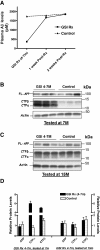Transient pharmacologic lowering of Aβ production prior to deposition results in sustained reduction of amyloid plaque pathology
- PMID: 22892055
- PMCID: PMC3477045
- DOI: 10.1186/1750-1326-7-39
Transient pharmacologic lowering of Aβ production prior to deposition results in sustained reduction of amyloid plaque pathology
Abstract
Background: Alzheimer's disease (AD) is the leading cause of dementia among the elderly. Disease modifying therapies targeting Aβ that are in development have been proposed to be more effective if treatment was initiated prior to significant accumulation of Aβ in the brain, but optimal timing of treatment initiation has not been clearly established in the clinic. We compared the efficacy of transient pharmacologic reduction of brain Aβ with a γ-secretase inhibitor (GSI ) for 1-3 months (M) treatment windows in APP Tg2576 mice and subsequent aging of the mice to either 15M or 18M.
Results: These data show that reducing Aβ production in a 2-3M windows both initiated and discontinued before detectable Aβ deposition has the most significant impact on Aβ loads up to 11M after treatment discontinuation. In contrast, initiation of treatment for 3M windows from 7-10M or 12-15M shows progressively decreasing efficacy.
Conclusions: These data have major implications for clinical testing of therapeutics aimed at lowering Aβ production, indicating that; i) these therapies may have little efficacy unless tested as prophylactics or in the earliest preclinical stage of AD where there is no or minimal Aβ accumulation and ii) lowering Aβ production transiently during a critical pre-deposition window potentially provides long-lasting efficacy after discontinuation of the treatment.
Figures




References
Publication types
MeSH terms
Substances
Grants and funding
LinkOut - more resources
Full Text Sources
Medical

